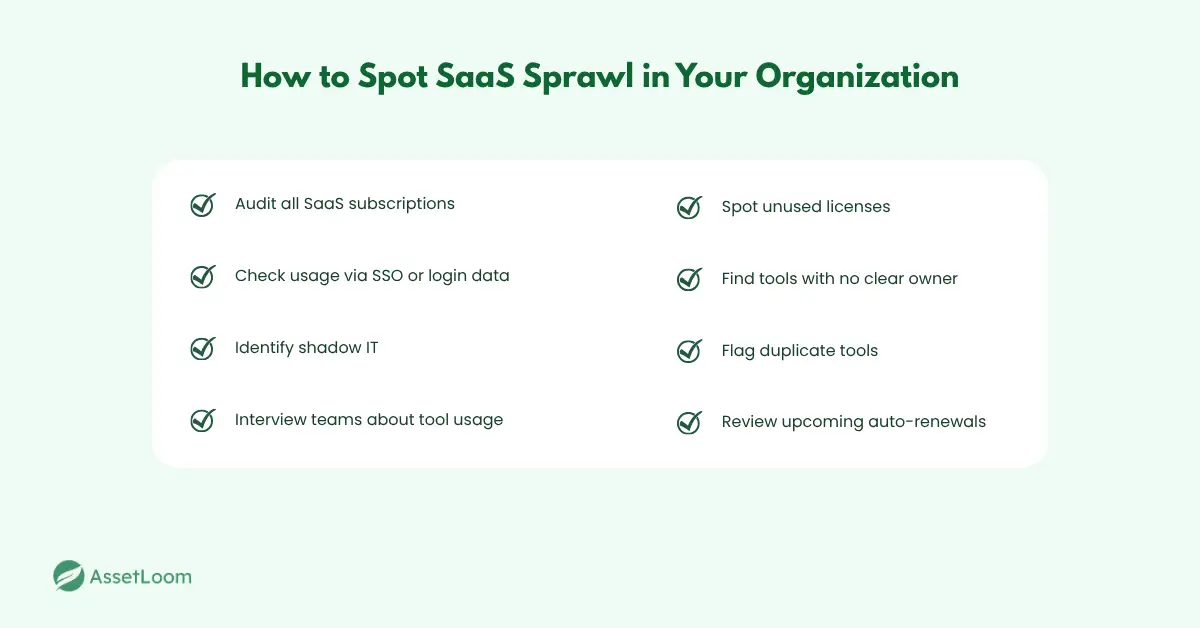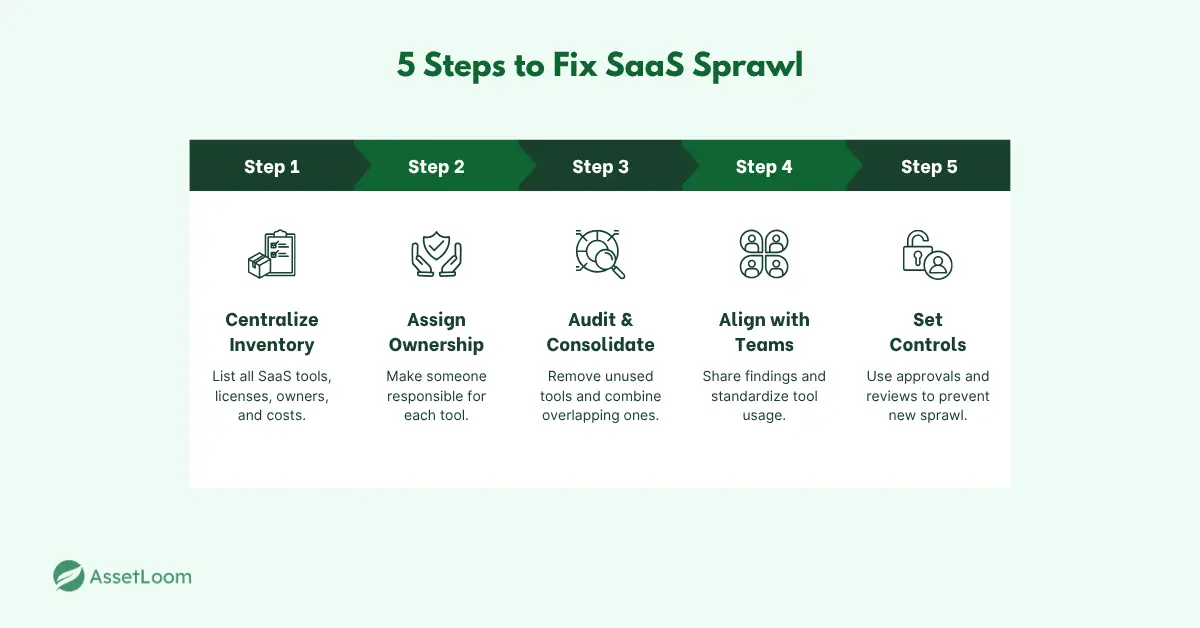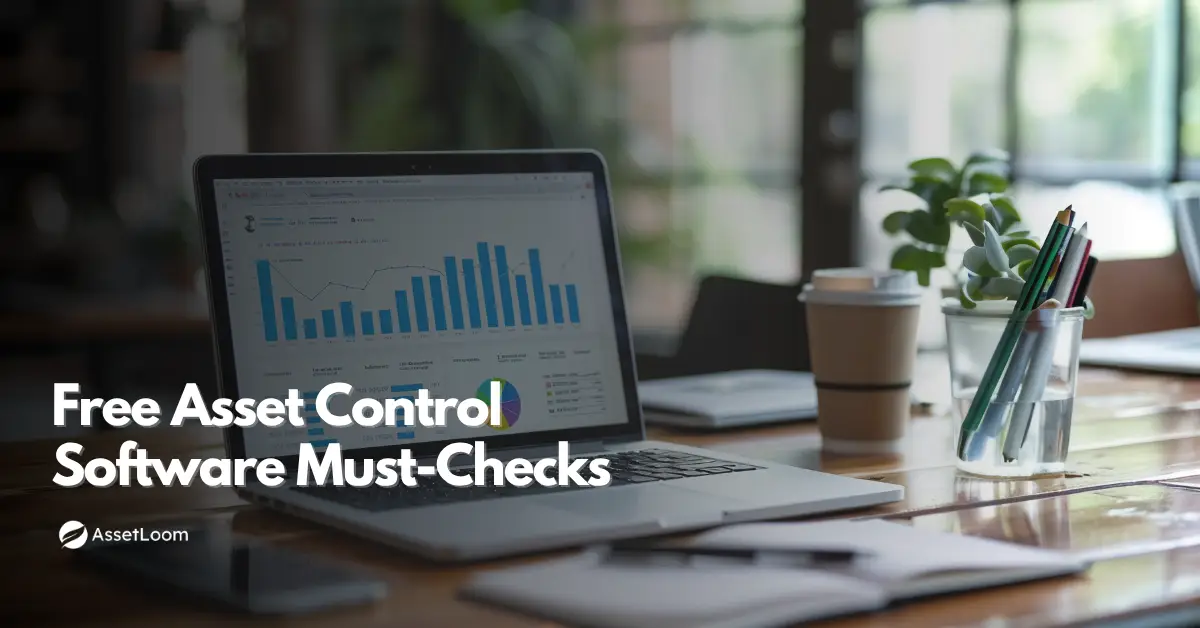Cut the Waste: How to Find and Fix SaaS Sprawl in Your Stack
Fighting SaaS sprawl? Learn how to spot wasted tools, cut costs, and take back control of your software stack.
You’re probably spending more on SaaS than you think. Not because you're scaling fast, but because your stack is bloated with tools no one uses, no one owns, and no one even remembers buying.
This is SaaS sprawl. And it’s not just a budget problem—it’s a control problem.
Marketing signs up for one tool. Sales prefers another. Ops rolls out something similar. Multiply that by a few years and a few dozen teams, and you’re left with a stack that’s leaking money, breaking workflows, and opening up security gaps you didn’t plan for.
The good news? SaaS sprawl is fixable.
This guide will show you how to find it, fix it, and prevent it from taking over your business again.
What SaaS Sprawl Looks Like in Real Life
SaaS sprawl rarely announces itself. It creeps in quietly—through quick team purchases, unused trial upgrades, and tools that never get offboarded after someone leaves.
Here’s what it looks like on the ground:
- Different departments are using three tools that do the exact same thing.
- Teams renew licenses automatically without checking usage.
- Old accounts still paying for software no one’s logged into in months.
If that sounds familiar, you’re not alone. Most organizations don’t have a clear system for software license management, especially when it comes to cloud-based tools. Without it, licenses pile up, costs spiral, and no one has a full picture of what’s actually in use.
Take a mid-size telecom company as an example. Over the course of a year, they ended up with four separate file-sharing tools—each adopted by a different department, none of them consolidated. The result? Confusion, wasted spend, and security risks from unmanaged user access.
SaaS sprawl isn’t just clutter—it’s a breakdown in visibility and control.
Why SaaS Sprawl Is a Real Problem
SaaS sprawl isn’t just messy—it’s expensive, risky, and hard to unwind if you let it build up.
It drains your budget. When every team buys its own tools, licenses pile up fast. Some overlap. Some go unused. And most renew quietly in the background without anyone checking if they're still needed. It’s easy to lose thousands each year just from poor visibility.
It slows your teams down. Too many tools mean scattered work. One team uses one platform, another uses something else. Nothing connects, data lives in silos, and everyone spends more time managing apps than doing actual work.
It opens up security gaps. When no one’s tracking access closely, things slip through the cracks. Former employees keep their logins. Contractors still have access long after their work is done. Tools pile up with no clear owner, and no one’s entirely sure who has access to what, or why. That kind of uncertainty is exactly what creates risk.
It makes audits harder than they need to be. When your software stack is all over the place, so is your documentation. That’s bad news when audit season hits or compliance questions come up. And if you’re in a regulated industry, it’s not just a hassle—it’s a liability.
But here’s the catch—most teams don’t even realize it’s happening until the costs start adding up. Spotting it early is the first step.
How to Spot SaaS Sprawl in Your Organization
You can’t fix what you can’t see. The first step to cutting SaaS waste is understanding exactly what’s in your stack—and what you’re paying for.
Start with an audit. Gather all your SaaS subscription data: invoices, credit card statements, and vendor contracts. Check your single sign-on (SSO) or identity provider logs to see which tools employees actually use. Don’t forget to dig into shadow IT—those tools teams adopt without IT’s knowledge.
Talk to your teams. Interview department heads and power users. Find out which tools they rely on—and which ones they don’t. Sometimes software sticks around just because no one has taken the time to cancel it.
Look for the red flags:
- Multiple apps are doing the same job.
- Licenses paid for but never used.
- Tools with no clear owner or point of contact.
- Automatic renewals you forgot to review.
Use the right tools. If you don’t have an IT asset management system or a SaaS management platform, now’s the time to get one. These tools give you centralized visibility and help track usage, licenses, and renewals in one place.
Finding SaaS sprawl isn’t glamorous, but it’s critical. Once you have a clear picture, you can move from chaos to control.

How to Fix SaaS Sprawl—Step by Step
Cleaning up SaaS sprawl can feel overwhelming, but breaking it down into clear, manageable steps helps you regain control and reduce costs effectively. Here’s a detailed approach you can follow:
1. Centralized Visibility with a Master SaaS Inventory
Start by creating a comprehensive list of every SaaS application your organization uses. This includes:
- Subscriptions are purchased by any department, not just IT.
- Tools acquired through credit cards or expense reports.
- Trial or pilot software that might have been forgotten.
Collect details like:
- Vendor names, subscription types, and contract terms.
- Number of active licenses vs. purchased licenses.
- Renewal dates and payment schedules.
- Assigned owners or point persons.
This centralized inventory is your foundation. Without it, you’re flying blind, making it impossible to understand where your money is going or where the risks lie.
2. Assign Clear Ownership and Accountability
One of the root causes of sprawl is unclear responsibility. Assign someone accountable for each SaaS tool. This might be:
- IT managers for infrastructure or security-critical apps.
- Department heads for productivity or function-specific tools.
- Procurement or finance for oversight of contracts and renewals.
Ownership means someone regularly reviews usage, approves renewals, and coordinates cancellations or consolidations. It also creates a direct contact for vendor management and audit requests.
3. Audit, Cancel, and Consolidate Licenses
With full visibility and ownership in place, dig into actual usage data. Compare the licenses you pay for with active users. Look for:
- Licenses that have gone unused for months.
- Multiple tools that serve the same purpose across different teams.
- Features that overlap within a single vendor’s ecosystem (e.g., different modules you may already have access to).
Take action:
- Cancel licenses that are unused or underutilized.
- Consolidate teams onto fewer tools where possible to reduce complexity.
- Negotiate with vendors to downgrade plans or bundle services to save money.
Remember to factor in cancellation policies and contract terms. Some vendors require notice periods or have penalties—plan your timelines accordingly.
4. Communicate and Collaborate Across Teams
SaaS sprawl often happens because departments work in silos. Prevent this by sharing:
- The SaaS inventory and findings with all stakeholders.
- Clear guidelines on approved tools and procurement processes.
- The cost and security risks tied to sprawl, to build shared ownership of the problem.
Regular cross-team meetings or newsletters can reinforce awareness and encourage proactive collaboration. When teams understand the impact of sprawl, they’re more likely to participate in cleanup and avoid unnecessary purchases.
5. Implement Strong Governance and Controls
To keep SaaS sprawl from creeping back, put controls in place:
- Require formal approval workflows before any new SaaS purchase or renewal.
- Schedule quarterly or bi-annual reviews of all subscriptions.
- Use role-based access management to limit who can provision new tools or licenses.
- Automate alerts for upcoming renewals and usage anomalies, if possible.
Taking these steps won’t just reduce costs—it will simplify your software environment, improve security, and make your teams more productive.

How to Prevent SaaS Sprawl Going Forward
Preventing SaaS sprawl requires ongoing effort and clear processes. To keep your software stack lean and efficient, focus on these key actions:
- Establish a formal SaaS procurement policy: Define clear rules for how new software requests are made and approved. This ensures all purchases align with business needs and budgets.
- Centralize purchases and renewals: Route all SaaS acquisitions and subscription renewals through a dedicated team, like IT or procurement. This prevents duplicate tools and helps negotiate better deals.
- Schedule regular SaaS reviews: Conduct quarterly or bi-annual audits of your SaaS inventory to identify unused licenses, redundant tools, or changing team requirements.
- Educate and engage your teams: Communicate the impact of SaaS sprawl on cost, security, and productivity. Encourage employees to use approved tools and report unused software.
- Leverage technology solutions: Invest in SaaS management platforms or IT asset management systems that provide real-time insights into usage, licensing, and renewal cycles.
By making these practices part of your routine, you’ll build lasting control over your software environment and avoid costly surprises down the road.
Conclusion
SaaS sprawl is a hidden drain on your budget, security, and team productivity. But it doesn’t have to be that way. By gaining clear visibility, assigning ownership, cleaning up your subscriptions, and putting strong controls in place, you can take back control of your software stack.
Prevention is just as important as cleanup. With smart policies, regular reviews, and team buy-in, you’ll keep sprawl in check and make sure every dollar spent on SaaS delivers real value.
Start with one audit. From there, the path to a leaner, safer, and more efficient software environment becomes clear. Don’t let SaaS sprawl quietly take over—cut the waste and make your tools work for you.

Related Blogs
Subscribe for Expert Tips and Updates
Receive the latest news from AssetLoom, right in your inbox.

